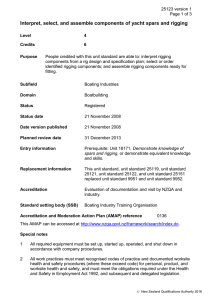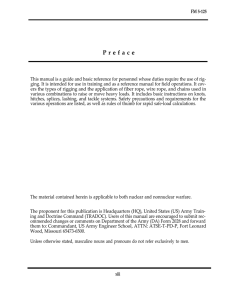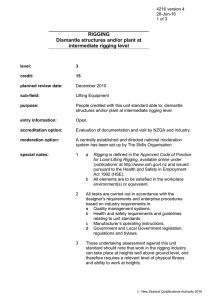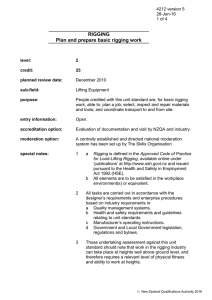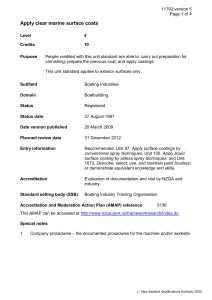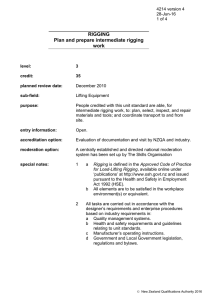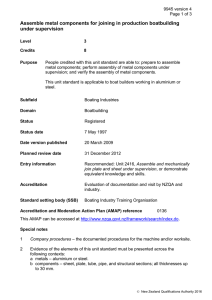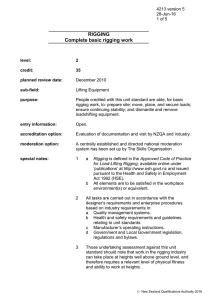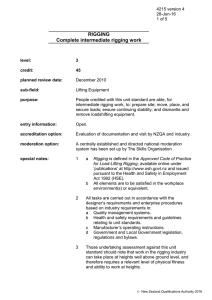Fabricate yacht rigging
advertisement
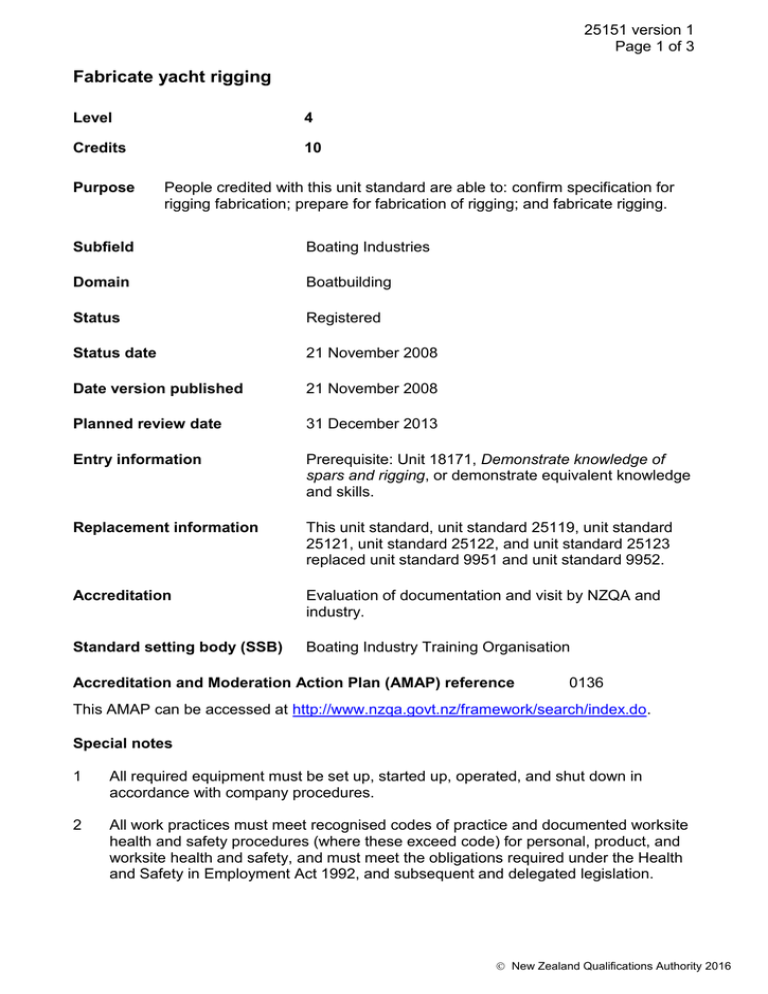
25151 version 1 Page 1 of 3 Fabricate yacht rigging Level 4 Credits 10 Purpose People credited with this unit standard are able to: confirm specification for rigging fabrication; prepare for fabrication of rigging; and fabricate rigging. Subfield Boating Industries Domain Boatbuilding Status Registered Status date 21 November 2008 Date version published 21 November 2008 Planned review date 31 December 2013 Entry information Prerequisite: Unit 18171, Demonstrate knowledge of spars and rigging, or demonstrate equivalent knowledge and skills. Replacement information This unit standard, unit standard 25119, unit standard 25121, unit standard 25122, and unit standard 25123 replaced unit standard 9951 and unit standard 9952. Accreditation Evaluation of documentation and visit by NZQA and industry. Standard setting body (SSB) Boating Industry Training Organisation Accreditation and Moderation Action Plan (AMAP) reference 0136 This AMAP can be accessed at http://www.nzqa.govt.nz/framework/search/index.do. Special notes 1 All required equipment must be set up, started up, operated, and shut down in accordance with company procedures. 2 All work practices must meet recognised codes of practice and documented worksite health and safety procedures (where these exceed code) for personal, product, and worksite health and safety, and must meet the obligations required under the Health and Safety in Employment Act 1992, and subsequent and delegated legislation. New Zealand Qualifications Authority 2016 25151 version 1 Page 2 of 3 3 All work practices must meet recognised codes of practice and documented worksite environmental procedures (where these exceed code) for personal, product, and worksite environmental matters, and must meet the obligations required under the Resource Management Act 1991, and subsequent and delegated legislation. 4 All work practices must meet documented worksite quality management requirements. These include documentation of activities, events, and decisions. 5 Definitions Company procedures, documented or accepted procedures in the workplace where the unit standard is being assessed. Job requirements, requirements that may or may not be specified but require correct choices to achieve including: following safety and workplace procedures and meeting generally accepted trade practice standards. Manufacturer’s specifications, written specifications or instructions that determine how equipment should be installed or used. Job specifications, either written or verbal definition of the job used for assessment. Fabrication, cutting and terminating wire, rope or aramid rigging types. May include talurit, swage, splice or a proprietary system. 6 This unit standard may apply to wire, rod, aramid, and rope rigging. Evidence is required for running and standing rigging. 7 This unit standard is intended to be assessed against on-job over a range of different rigging fabrication job types and sizes. Elements and performance criteria Element 1 Confirm specification for rigging fabrication. Performance criteria 1.1 Rigging type is confirmed and selected in accordance with job specifications. 1.2 Rigging dimensions are confirmed in accordance with job specifications. 1.3 Termination types are confirmed in accordance with job specifications. Element 2 Prepare for fabrication of rigging. Performance criteria 2.1 Fabrication equipment is confirmed as being in working order in accordance with company procedures. 2.2 Safety equipment is complete, in working order, matches the requirements of the task, and is used in accordance with job requirements. New Zealand Qualifications Authority 2016 25151 version 1 Page 3 of 3 2.3 Rigging is prepared in accordance with manufacturer’s specifications and company procedures. Element 3 Fabricate rigging. Performance criteria 3.1 Rigging is fabricated in accordance with manufacturer’s specifications and company procedures. 3.2 Safety equipment is used in accordance with company procedures. Please note Providers must be accredited by NZQA, or an inter-institutional body with delegated authority for quality assurance, before they can report credits from assessment against unit standards or deliver courses of study leading to that assessment. Industry Training Organisations must be accredited by NZQA before they can register credits from assessment against unit standards. Accredited providers and Industry Training Organisations assessing against unit standards must engage with the moderation system that applies to those standards. Accreditation requirements and an outline of the moderation system that applies to this standard are outlined in the Accreditation and Moderation Action Plan (AMAP). The AMAP also includes useful information about special requirements for organisations wishing to develop education and training programmes, such as minimum qualifications for tutors and assessors, and special resource requirements. Comments on this unit standard Please contact the Boating Industry Training Organisation training@bia.org.nz if you wish to suggest changes to the content of this unit standard. New Zealand Qualifications Authority 2016
